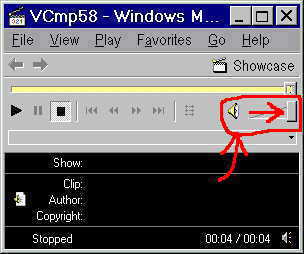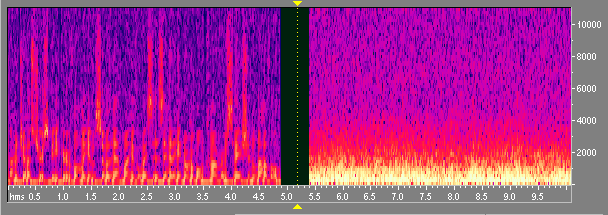It has the following waveform amplitude pattern:

| People
Over Planes, Inc.
of Contra Costa County, California P.O. Box 2336, Pleasant Hill, CA 94523 (peopleplanes@oocities.com) Send us an e-mail request to receive notices of upcoming airport meetings by e-mail. |
Last
Updated
July 20, 2000. |
| An information group providing the community with information on the operation of Buchanan Field airport from the perspective of the community. | |
| How
Loud is a BAe-146-200A?
If your computer has a sound card and speakers, you can click on the below sound file and find out. |
| The FAA's Circular 36-3G estimates the noise generated by a BAe-146-200A
as being 76.5 dBA on takeoff, as measured 6500 meters from the starting
position of the takeoff. For Buchanan, the 6500-meter point corresponds
to 3 miles from the end of the runway, which would be 1/2 mile past Boyd
Road in Pleasant Hill, assuming that the Jet followed Contra Costa Blvd.
on its departure. The quietest hush-kitted DC-9 that we could find
on Circular 36-3G rates at 76.3 dBA. The sound level of these airplanes
at 1.5 mile from the end of the runway will be approximately 6 dBA higher
(82.5 dBA), and at 6 miles from end of the runway will be approximately
6 dBA lower (70.3 dBA).
It is important to emphasize that the FAA Circular 36-3G has some limitations, which we point out below. In our estimation, the sound file you will hear will be well within 6dB of a worse case fly over at 3 miles out, if not within 3 dB. The pilot can take measures to reduce this level even further, such as by reducing power, but there no way that an airport can mandate such action. The 76.5 dBA number provided by the FAA for BAe-200A is based on the condition that "thrust cutback [is] used", and is "based on manufacturer's data." In the following experiment, you will play a sound filed that is divided into two segments: (1) a normal conversation volce at 60 dBA (quiet room with the speaking person 4 to 5 feet away from you), and (2) jet noise at 76.5 dBA. While the first segment is playing, you will adjust your computer's sound system so that it outputs a voice at a normal conversation level, such as one that you would encouter in a quiet living room with the speaking person 4 to 5 feet away. This experiment is, of course, an approximation because your initial adjustment with the first file will not be exactly on 60 dBA (unless you have a precision sound meter and can adjust your speaker's volume using the meter). The level of the sound may be reduced in practice if the pilot cuts back on the power. However, there is no way to legally mandate that the pilot do so. Furthermore, the sound file is only for takeoff, or departure, conditions. Noise levels on approach to the airport can vary widely. If the plane is arriving to the airport at a high altitude, it can essentially glide in with low thrust on the engines. If the plane arrives to the ariport at a low altitude, it usually has to extend flaps to maximum settings and power on the engines to a much higher thrust level. |
| STEP 1: Download the Following file by clicking on it: Demonstration Sound File (200K WAV file) |
|
It has the following waveform amplitude pattern:
|
| As a result of step 1, your browser should
bring up a software player window, as shown below for Netscape Navigator
and Microsoft Explorer.
STEP 2: Turn the volume bar on the player software window to the maximum value, as indicated by the red pencil markings on the graphics below. |
|
NETSCAPE
 |
MICROSOFT EXPLORER
 |
| STEP 3: Click
the play button on the player software window, then adjust the
volume knob of your speaker, during the first sound segment,
to a level where the sound file sounds as though the recorded voice is
at a normal conversation level in a quiet room with the person 4-5 feet
away, as indicated above (60 dBA). You may have to play the sound
file several times to make the adjustment, but after that you should hear
the sound of a jet at around 76.5 dBA.
According to the FAA's Circular 36-3G, this is the amount of noise made by the BAe-146-200A at three miles from the end of the runway (that's about 1/2 mile south of Boyd Road in Pleasant Hill), and as measured outdoors. The level of the sound may be reduced in practice if the pilot cuts back on the power. However, there is no way to legally mandate that the pilot do so. At 1.5 miles from the runway, the sound that you will hear on this sound clip will be approximately 6dBA higher in volume. |
|

Here is a graphical representation of the frequency spectrum versus time for the two segments of the Demonstration sound file. (White=high, red=moderate, blue=low) |
| Limitations of the FAA's circular 36-3G.
The dBA ("A-weighted") noise levels on the circular were estimated for each airplane as they might occur during type certification tests conducted under Appendices A, B, and C of 14 CFR part 36. However, the reported levels are estimates and do not represent actual certificated values. This is because certification data are reported to the Federal Aviation Administration (FAA) in units of EPNdB for large transport category airplanes and turbojet powered aircraft rather than dBA. The FAA indicates that, where possible, the levels in dBA were estimated from certification data. Where this was not possible, we suspect that the FAA used a conventional conversion factor between EPNdB and dBA that assumes a particular frequency distribution of the noise, which may or may not be representative of the jet noise being so converted. In this regard, the entry for the BAe-146-200A states that the 76.5 dBA number is "based on manufacturer's data." Additionally, the noise levels on the FAA circular were estimated as they might occur during type certification tests conducted under Appendix C of 14 CFR part 36, these values are intended to provide a consistent basis for comparison of noise levels of major aircraft models rather than establishing absolute levels of individual aircraft. Having said that, we believe that the FAA attempts to be as close to the absolute value as possible since many airports have noise ordinances that are based on the circular. Finally, the noise levels of individual aircraft may also differ due to variations in weight and operating procedures from those used during certification. For instance, takeoff noise levels are reduced substantially as aircraft takeoff weight is reduced. Takeoff weights during normal in-service operations are often less than the maximum certificated weight. In this regard, the 76.5 dBA number provided by the FAA for BAe-200A is based on the condition that "thrust cutback [is] used". More information on the FAA's Circular 36-3G can be found by clicking here. An Invitation to the Aviation Industry.
|
| Back to Air Carrier Page |